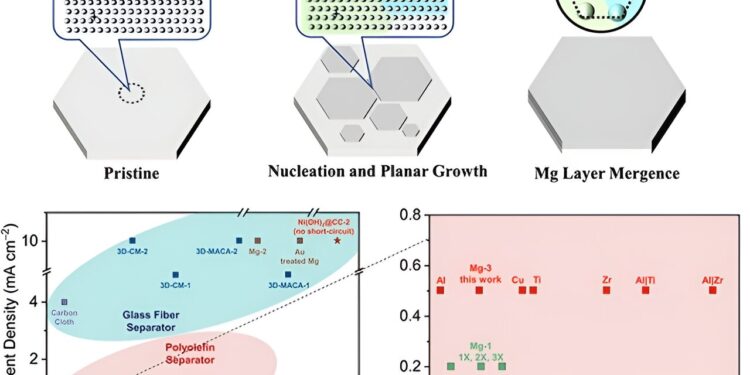Schematic diagram of the layer-by-layer planar growth pattern of magnesium deposits and comparison of the performance of various electroplating substrates. Credit: Wang Guixin & Du Aobing
As promising candidates for current lithium-ion batteries, magnesium rechargeable batteries have attracted great attention due to the superior properties of magnesium (Mg) metal anodes, such as high volumetric capacity (3,833 mAh/cm) .3), abundant resources, respect for the environment and difficult to cultivate dendrites.
Although some studies have reported that Mg dendrite morphology can be observed under extreme electroplating conditions, such as using limited Mg electrolytes with low Mg ion conductivity and applying density of ultra-high current (10 mAh/cm2), these test conditions are clearly different from the practical requirements.
Researchers from the Qingdao Institute of Bioenergy and Bioprocess Technology of the Chinese Academy of Sciences (CAS) found that using the practical polyolefin separator effectively causes the coin cell battery to short circuit even at low current density. They established a layer-by-layer planar growth model for short circuit suppression and proposed the design strategy of 3D magnesiophilic substrate to achieve planar electroplating/stripping behavior of magnesium.
The study was published in ACS Energy Letters on December 4.
Extensive evidence has shown that the growth of magnesium is uniform and dense when the current density is less than 5 mAh/cm.2. However, using practical polyolefin separators with small thickness, low current charging and discharging may cause internal short circuit in button batteries.
The researchers proposed the island growth model for Mg deposits, based on electrochemical tests and microscopic observations of morphology, which reasonably explains the anomalous short circuit behavior.
By further adjusting the lattice disparity parameters and surface energy of the substrate, the layer-by-layer planar growth of Mg deposits is achieved, effectively solving the above abnormal short circuit problem.
The researchers used a 3D magnesiophilic substrate (Ni(OH)2@CC) with low lattice imbalance and high surface energy properties as an electroplating substrate, which not only enables the reversible electroplating/stripping process, but also coupled with high charge MB6S8 cathode (30 mg/cm2) .
By deeply exploring the short circuit phenomenon caused by abnormal nondendritic electroplating behavior in RMBs and proposing validated solutions, this work provides an important driving force for the practical application of magnesium metal anode.
More information:
Guixin Wang et al, Realization of planar electroplating/stripping behavior of magnesium metal anode for practical magnesium battery, ACS Energy Letters (2023). DOI: 10.1021/acsenergylett.3c02058
Provided by the Chinese Academy of Sciences
Quote: A 3D Magnesiophilic Substrate Enables Planar Electroplating/Pickling of a Magnesium Metal Anode (December 27, 2023) retrieved December 27, 2023 from
This document is subject to copyright. Apart from fair use for private study or research purposes, no part may be reproduced without written permission. The content is provided for information only.



